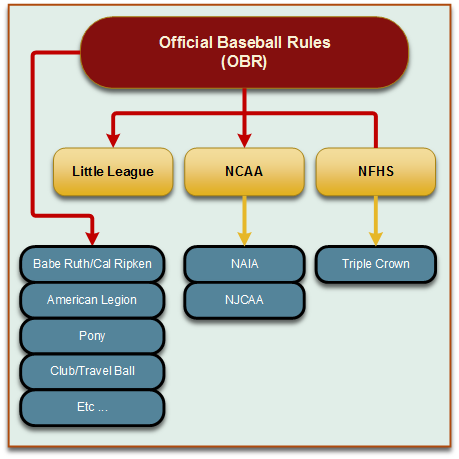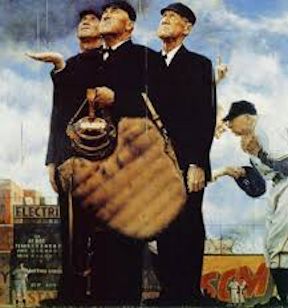
Training Umpires, Part 2: Rules of the Game
Somewhere north of 80% of baseball is played with fewer than 20% of the rules. If my numbers are off on this point, they're not off by much. So the average person stepping onto the field for the first time (likely to umpire his or her seven-year-old's Little League game) already brings a lot of baseball knowledge to the field. There's comfort in that ... but there's peril, too.
The point is, while you're probably pretty solid with safe/out, fair/foul, and ball/strike, umpiring anything older than about nine-year-olds is going to take a lot more experience with that not-often-called, other 80% of the rules.
Instruction in the rules of the game is quite different from teaching field mechanics. While field mechanics rely largely on developing muscle memory and physical reactions to fast action, applying rules in real time relies more on rapidly processing visual cues. Often this is very easy, for example when an infield batted ball if fired to the first baseman two steps ahead of the runner arriving. Other times, however, it can be quite difficult, particularly when there is a “bang-bang” play at a base, or when there’s overthrows and errors and chaos and confusion on the base paths, runner going every which way, and maybe interference here, or obstruction over there.
(For a bit of tongue-in-cheek about this, see The Theory of Umpire General Relativity, and you also might like First Base Bites.)
With field mechanics you can prepare yourself in advance of the pitch (just as fielders do) and preview what you’ll need to do when a batted ball goes into play. With rules, on the other hand, you can’t do this. Instead, you have to observe, recognize, then process, then rule.
Background and basics of the rules
Let’s start by admitting an unavoidable fact: It’s all but impossible to become familiar (let alone proficient) with the entire sweep of the rules of baseball when first learning the craft. Not only is the rule book a thick one, but because the game (and the rules of the game) have evolved slowly over the course of almost two centuries, there are fuzzy nooks and crannies in the rules, some blind alleys and one-way streets that take time and experience to fully absorb.
Take for example the rule that defines and describes ruling on a checked swing. Oh, wait a minute. There’s no definition of a swing. And there is no checked-swing rule. How can that be? Umpires rule on checked swings all the time. Well … get used to it.
 Further complicating the picture is that there are a variety of rule sets. The differences pertain primarily to the inclusion of safety-related rules in youth and other amateur leagues, and also various substitution rules.
Further complicating the picture is that there are a variety of rule sets. The differences pertain primarily to the inclusion of safety-related rules in youth and other amateur leagues, and also various substitution rules.
The flow chart pictured here illustrates this division. Three groups, the NCAA, NFHS, and Little League, have each developed, copyrighted, and published their own rule sets. The remaining leagues and organizations use OBR, NCAA, or FED rules, but with supplementary, league-specific modifications. For a more extensive discussion of this topic, have a look at our article Baseball Rule Sets.
So where do we start?
So this all begs the question, where do we start? If we can’t expect a new umpire to become proficient with the whole rule book, how much of the book do we teach beginners?
We should start, obviously, with that portion of the rules that nearly everyone brings with them from their exposure to the game throughout their youth: ball/strike, safe/out, fair/foul, and the basics of base running and pitching. Each of these natural pairings lead to some natural extensions, like the following for example (you can add, subtract, or change the following suggestions any way that you think makes sense):
- Safe/out: Catch, tag, infield fly
- Fair/foul, ball out of play: Foul ball defined, live ball/dead ball, foul tip, overthrow out of play
- Ball/strike: Strike zone, checked swing, batter’s box, catcher’s interference
- Base running: Interference, obstruction, base path (out of), running lane, awarding bases, time plays, proper appeals, sliding, runner touched by batted ball, runner touched by thrown ball
- Pitching: Legal pitching positions, illegal pitches
These are just examples of how you can build out a baseball rules training program by building around familiar groups of baseball action on the field. Building your rules training around these basic groupings works well because the portions of the rules that are familiar lead naturally into those rules that may be less so. It gives the student a familiar on-ramp to groups of related rules and reinforces knowledge of rules that are less familiar.
The meat and potatoes, so to speak, are in rules 5.0 and 6.0. (Note that my rules numbering follows the Official Baseball Rules (OBR); rule books for youth leagues may number the rules differently.) Rules 5.0 and 6.0 are the sections of the rule book on which your rules instruction needs to concentrate. But not infrequently, after stumbling through rules 1.0, 2.0, 3.0 and 4.0, the classroom is half asleep by the time you get there.
Furthermore, teaching the rules by following the rule book can easily lead to confusion because, as we know, the rules are discontinuous. That is, we often have to refer to multiple rules (plus “Definitions”) to get to a single point (take interference for example).
It makes a lot more sense to organize rules instruction around topics (again, take interference as an example) and then you can reference the many discontinuous rules as mere bullet points around the central topic. The topic of interference is a good example because the entire scope of interference, including all of its types, is scattered across 42 different rule citations. Don’t believe me? Take a look at the table at the end of the article. And then think about walking a student across a landscape like that!
The way the rules discussions are organized on our website, we cover this entire labyrinth of interference rules in just five articles: Offensive Interference, Defensive (“Catcher’s”) Interference, Batter’s Interference, Umpire Interference, and Spectator Interference. For new umpire training, covering just the first three of these is sufficient.
When developing your rules instruction program you can normally make some prior assumptions. For example, you can assume that new umpires are most likely starting out in youth ball, and likely at lower levels. This will not always be true, but we have to start somewhere.
At lower levels, for example (we’re talking about 12 years old and younger), base-running rules limit stealing, and pitching rules are relaxed. There will be no pick-off attempts and there are no balks (although there are illegal pitches, for example, the quick pitch and pitching while not engaged to the rubber). This alone eliminates a significant portion of the rule book that you can overlook (or skim) when training new umpires.
Umpire training materials
In our article Getting Started Umpiring we list and link to a great many resources for helping with umpire training. Chief among these are training materials provided by Little League, particularly their Little League University.
Little League also provides a free downloadable PDF version of its comprehensive Rules Instruction Manual (RIM), which is a very useful reference text. Again, though, the RIM is structured around the rule book and follows it rule after rule so you’ll need to jump around when covering individual rules topics.
Wrapping up ... for your consideration
To help illustrate how cumbersome it is trying to teach the rules of baseball right out of the rule book (whether OBR or any other), I've listed here the 42 rules citations that encompass the entire scope of interference in the Official Baseball Rules (OBR). Looking this over is not a pointless exercise.
| OFFENSIVE INTERFERENCE | |
| Definitions: Interference (a) | Definition of offensive interference |
| 6.01(a) entire (11 sections) | Batter/runner interference |
| 6.01(c) | Catcher's interference |
| 6.01(f) | Coach's interference |
| Rule 6.01(a)(8) | Coach interferes by assisting runner |
| 5.09(a)(11) | Running lane interference |
| 5.09(b)(3) | Runner interferes with thrown ball |
| 5.09(b)(7) | Runner touched by fair batted ball |
| 6.03(a)(4) Comment | Backswing ("weak") interference |
| 5.09(b)(8) | Batter's interference |
| 5.09(a)(8) | Bat hits ball second time in fair territory |
| DEFENSIVE INTERFERENCE | |
| Definitions: Interference (b) | Definition of defensive (catcher's) interference |
| 5.02(a) | Catcher must remain in catcher's box |
| 5.05(b)(3) and Comment | Catcher's interference clarification |
| 5.06(b)(3)(D) | Interferes with runner attempting to steal |
| 6.01(g) | Interferes with runner on steal of home |
| BATTER'S INTERFERENCE | |
| 6.03(a)(3) | Interferes with catcher fielding or throwing |
| 5.09(b)(8) | Interferes with a play at home |
| 6.01(a) (1-5) (5 sections) | Batter interference |
| UMPIRE INTERFERENCE | |
| Definitions: Interference (c) | Definition of umpire interference |
| 5.06(c)(2) | Plate umpire interferes with catcher's throw |
| 5.06(c)(6) | Fair batted ball touches umpire in fair territory |
| 5.05(b)(4) | Fair batted ball touches umpire before passing a fielder |
| 5.05(a)(4) | Fair batted ball touches umpire after passing a fielder |
| 6.01(f) | Umpire accidentally touched by thrown ball |
| SPECTATOR INTERFERENCE | |
| Definitions: Interference (d) | Definition of spectator interference |
| 6.01(e) | Spectator interference rule and remedies |
| 5.08(b) Comment | Fans rushing onto the field |

